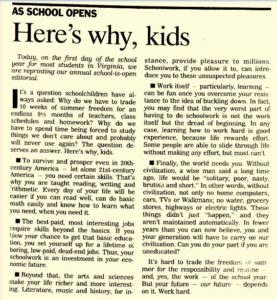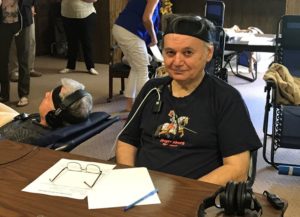Courtesy of a comment from Martha MacBurnie, this very interesting piece.
http://www.dailygood.org/story/2079/change-the-worldview-change-the-world-drew-dellinger/
Courtesy of a comment from Martha MacBurnie, this very interesting piece.
http://www.dailygood.org/story/2079/change-the-worldview-change-the-world-drew-dellinger/
About a thousand years ago, I was an editorial writer for the Virginian-Pilot and Ledger-Star, a very satisfying time in my life. It was an easy job: write six editorials a week and compose the op-ed page. After my previous years in the wilderness as a computer programmer, it was more an entertainment than an occupation.
Editorial, in the nature of things, tend to be ephemeral. Today’s preoccupations are tomorrow’s yawn. Nothing deader than yesterday’s news, except perhaps yesterday’s opinions about it.
Still, once in a while, it’s possible to say something and meet response. For a couple of years, the VP/LS continued to run this editorial every September even after I was gone. Seems to me it’s just as germane as ever.

Good or bad, who knows, but it is going to have profound effects.
An important issue, courtesy, as so often, of SchwartzReport.
https://www.theguardian.com/commentisfree/2018/aug/25/skim-reading-new-normal-maryanne-wolf
A friend points me to this excerpt from Elephant Journal:
https://www.elephantjournal.com/2018/07/7-carl-jung-quotes-to-raise-our-consciousness/
Sarah Laskin was a participant in an earlier version of the Monroe Institute course featuring Mind Mirror, and in the institute’s blog shared her experiences, which should be of interest.
https://www.monroeinstitute.org/blog/all-wired-eeg-adventures-remote-viewing-and-obe-novice
July 10, 2018
4 a.m. I’ve just experienced something that I actually interrupted in order to come upstairs and type it out. I wouldn’t ordinarily interrupt an experience, but this is different.
I woke up at 3:20 a.m. or so, congested and not really right. (For the past few days, the temperature has been in the 70s rather than in the 90s as it had been previously, and while that is pleasant in itself, the dip seems to have affected me in the way that the coming of Autumn does: For several days I have had to use the inhaler to stave off asthma.) So although I got up and got out my journal, I wasn’t really up to doing anything. I made a couple of notes, checked email, played a game.
In the course of listing what was going on with me – a song stuck in my head; nose and ears stuffed up; sniffles – I wrote, “It will be interesting to see if this keeps me from living in alpha,” which is my shorthand description of what I have been doing since discovering it in last month’s Discovery program. That is, maintaining an even, calm, eyes-open high alpha. And as I wrote that, I thought, do the waterfall.
(The waterfall meditation was given to Rita and me many years ago. It amounts to this: Envision yourself standing under a waterfall, with the waters – the waters of life and health – flowing not only over you, but through you. As they flow over and through you, the waters carry away detritus from your physical, mental and emotional life. That is, they wash away what is no longer serving you, and leave you refreshed and to that extent regenerated.)
So, I did the waterfall. And as I envisioned the waters flowing through me, I followed them, so to speak, watching (feeling, really) as they progressed from my head to my toes. As I did, I noticed as usual that they flowed easily through some places, and sort of stuck at others, and those other places were of course the areas needing help. It occurred to me, the way to use that bit of feedback was to split my attention, with one part following the waters smoothly and another part offering extra assistance, so to speak, to the places where the “stuck” spots indicated something needing help.
As I did:
(a) The tune in my head didn’t quite go away, but vastly reduced its volume, until it was only a scarcely noticed background presence. (It’s still annoying that I can’t get rid of it at the moment, but I’ll take “better,” any time.)
(b) My nose cleared up, and after a while one of my ears popped and most of the congestion was gone.
I take it that (b) may have been the result of the waterfall, but (a) is probably the result of the effort of moving into alpha. And then it occurred to me, we can use the reduction of symptoms as a feedback mechanism! Yes, we want the symptoms to go away, and even more so the causes, but at the same time, they may be useful in and of themselves, as biofeedback.
I got all excited at the idea of sharing that thought, so there it is. I hope it helps somebody. Symptoms as biofeedback.
It will be a while before I’m ready to post an account of my week at The Monroe Institute’s Discovery program, but here’s a photo my friend Steve Winchester took of me, wired up, ready for Mind Mirror to record my brain waves while I attempt to perform certain mental feats.

You can’t tell from this photo, but four electrodes are attached with goop to specific places on the back of our skulls, and the headband slipped over them to help prevent them from becoming detached.
With 16 people to be wired up, four people to a pod (that is, each group of four wired to the same machine), it could take a while to get going! That’s my friend Dirk Dunning on the gravity chair behind me, already wearing his earphones (you can see mine on the table in front of me) and, like me, waiting for the show to get on the road.